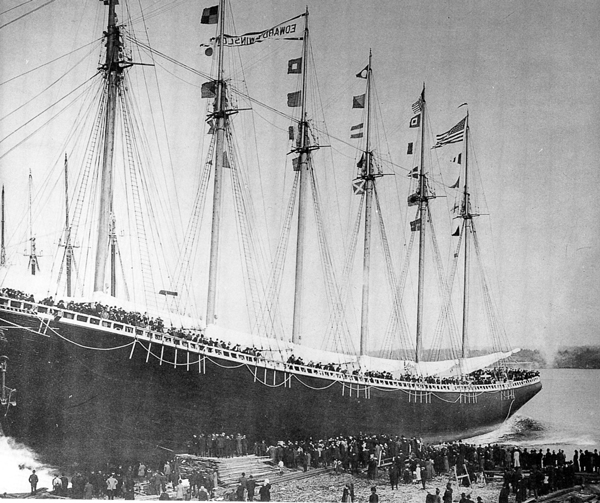B A C K T H E N
The Edward B. Winslow

A warm November day, 1908. The six-masted schooner Edward B. Winslow departs the Bath yard of Percy & Small. Smoke from the greased launching ways swirls around her stem. Just before the 12:30 launching, a poem by Mrs. Susie Wilson, of Portland, was recited by Mrs. Henry Butler, the captain’s wife. It concluded with:
Proud Queen, thou art impatient to be gone,
To sail in freedom o’er the waters wide.
Fair river, take her to your willing arms—
Old ocean waits to claim his lovely bride.
Many of the guests had arrived on the noon train from Portland, five extra cars having been added to accommodate them. About 600 launched aboard the giant schooner, the Bath Times commenting upon the “ease and celerity with which the numerous ladies in the party ascended the staging steps and got over the rail of the craft.” The launching went off without a hitch, and the schooner “presented a beautiful picture while in the stream with her handsome set of colors flying to the breeze and in her dress of shining paint.” As the tugs Seguin and Charlie Lawrence brought the Winslow back to the wharf, caterer J. J. Pooler, of Portland’s Columbia Hotel, assisted by eleven of his hotel waitresses, served a “sumptuous” banquet featuring lobster Newberg, mouseline of chicken, cold ham, tongue, chicken salads, rolls, olives, sandwiches, fruit punch, and coffee. Captain and Mrs. Butler, and Edward B. Winslow himself, a Portland stoneware magnate, held an informal reception in the cabin.
Built for the J. S. Winslow (no relation to the namesake) fleet of Portland, the schooner measured 3,424 tons. (In 1909 Percy & Small would build the mighty six-master Wyoming, of 3,730 tons.) The Winslow’s registered length was 318.4 feet, with 425 feet between jibboom and spanker boom ends. (The spanker boom measured eighty feet, five feet longer than the jibboom.) The schooner’s distant ends were connected by telephone. Her beam was fifty feet, her depth of hold twenty-nine feet. The oak frame was reinforced with steel strapping, let into the frames to provide longitudinal stiffening. The importance of the big schooner’s ground tackle was reflected by its size, the stockless bower anchors weighing 8,700 pounds apiece, shackled to 2 7/8-inch chain. Hawsepipes weighed 3,500 pounds apiece. The windlass, bult by Bath’s Hyde Windlass Co., was the largest yet fitted to a sailing vessel.
Founded in 1894, Percy & Small built seven of the ten East Coast six-masters. (Two other wooden sixes were built at Camden and Rockland.) Equipped with an electric-powered sawmill, the firm did business based “on modern methods and old fashioned principles.” At the launching of the Winslow’s sister, the Edward J . Lawrence, the press reported that the combined length of the twenty-seven schooners built by the firm exceeded a mile and a quarter. Over the next twelve years Percy & Small built fifteen additional schooners, adding two-thirds of a mile to the total. Total schooner tonnage built amounted to 81,000; total number of masts stepped, 193. The firm managed a number of the schooners that it built.
The huge schooners were a bold and generally profitable response to the disorganized state of the bituminous coal trade, caused largely by increased demand and inadequate loading facilities at the mid-Atlantic coal ports. (In the fall of ‘99 Sanford’s Goodale Mills, unable to buy coal, was forced to burn 200 cords of wood daily.) Colliers were long delayed at coal ports; schooners were far cheaper to build and to operate per ton than were steamers, and demurrage—money paid by shippers on undue detention of a chartered vessel—could be profitable. Early in 1900—the year that the first two six-masters were built—a four-master arrived at Boston with 1,500 tons of coal delivered for $840 more than the coal was worth, thanks to prolonged demurrage at $90 per day. With most of the crew paid off, her expenses lying at anchor had been but $10 per day.
The Percy & Small shipyard is today the site of the Maine Maritime Museum.
Text by William H. Bunting from A Days Work, Part 1, A Sampler of Historic Maine Photographs, 1860–1920, Part II. Published by Tilbury House Publishers, 12 Starr St., Thomaston, Maine. 800-582-1899.
